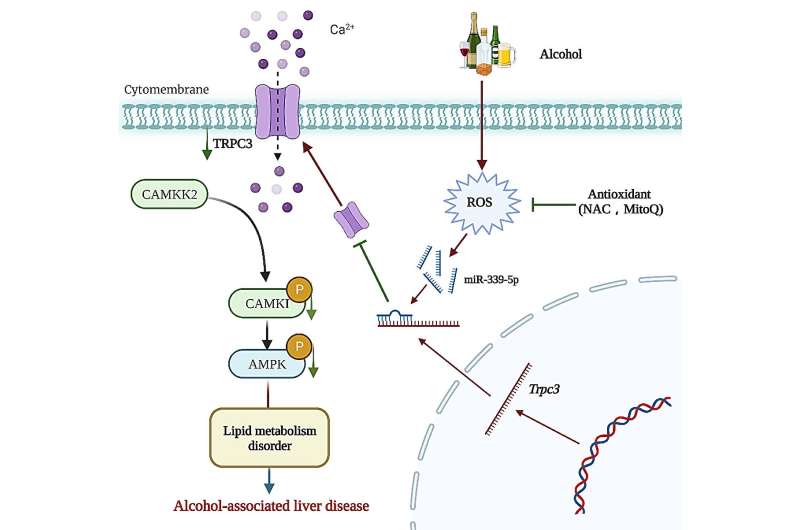This article has been reviewed according to Science X's editorial process and policies. Editors have highlighted the following attributes while ensuring the content's credibility:
fact-checked
proofread
Hepatic TRPC3: An emerging regulator of alcohol-associated liver disease

Excessive alcohol intake is strongly associated with alcohol-associated liver disease (ALD) which accounts for 25% and 30% of deaths from cirrhosis and hepatocellular carcinoma. Impairment of Ca2+ influx and Ca2+-mediated signaling in ALD suggests that Ca2+ channels are important in ALD pathological progression.
TRPC (transient receptor potential cation channel protein C) is an evolutionarily conserved non-selective cation channel protein primarily located in the cell membrane with six transmembrane segments. So far, four TRPC subfamilies have been identified, categorized into TRPC1, TRPC2, TRPC4/5, and TRPC3/6/7. Among them, TRPC3 is the most well-studied member of TRPC, and it is commonly expressed in both excitable and nonexcitable cells, including hepatocytes.
TRPC3 maintains cell survival by controlling Ca2+ inflow, prevents apoptosis induced by various stimuli, and promotes immune responses. However, the biological role of hepatic TRPC3 in ALD pathology remains unclear.
An article published in Life Metabolism titled "Hepatic TRPC3 loss contributes to chronic alcohol consumption-induced hepatic steatosis and liver injury in mice" reports on the role of TRPC3 in ALD by regulating the Ca2+/calmodulin-dependent protein kinase kinase 2 (CAMKK2) signaling pathway.
First, the investigators found that TRPC3 was significantly reduced in the liver tissues of ALD individuals and ALD mice established by feeding them with a Lieber-De Carli ethanol-containing liquid diet. Liver-specific knockdown of TRPC3 in mice significantly aggravated alcohol-induced hepatic injury, lipid deposition, inflammation, and fibrosis.
On the contrary, liver-specific overexpression of TRPC3 remarkably restored chronic alcohol intake-induced hepatic injury, lipid deposition, inflammation, and fibrotic lesions.
It has been known that chronic alcohol consumption inhibits hepatic AMP-activated protein kinase (AMPK), a core regulator of energy metabolism. However, the link between alcohol exposure and AMPK inhibition in the liver remains unclear.
In the study, the authors found that liver-specific knockdown of TRPC3 enhanced alcohol's inhibitory effect on AMPK through a mechanism of Ca2+-dependent CaMKK2 activation. Bioinformatics analysis and experimental evidence showed that miR-339-5p is an upstream regulator involved in TRPC3 reduction in ALD.
In addition, antioxidant supplementation attenuated alcohol-induced reduction of TRPC3 in mouse liver, suggesting that oxidative stress is a key factor in the regulation of miR-339-5p and TRPC3. Taken together, oxidative stress-induced miR-339-5p/TRPC3/Ca2+/CaMKK2-dependent AMPK inactivation is the key pathological pathway in ALD pathogenesis, providing a potential translational application of TRPC3 as a therapeutic target in ALD.
More information: Qinchao Ding et al, Hepatic TRPC3 loss contributes to chronic alcohol consumption-induced hepatic steatosis and liver injury in mice, Life Metabolism (2023). DOI: 10.1093/lifemeta/load050





















